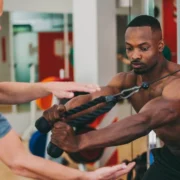When Your Fit-spiration is a Fraud

With the rise of alterations in fitness influencers’ social media posts, how do we know who to trust?
In the age of doom-scrolling, glancing at a picture for a few seconds is normal. But if you look closer at influencers’ photos, you may notice warped backgrounds or small inconsistencies that point towards a larger problem.
A market for apps and web services have sprung up around body- and face-editing. In a matter of seconds, influencers can use apps like CapCut, BodyTuneEditor, Facetune, and FaceApp to change their appearance. Even videos and livestreams can now be edited. How do followers tell what’s real and what’s fabricated?
Anti-influencers have popped up, calling out celebrities and influencers for their edits. John Dorsey, known online as “Goob,” is known as “your favorite influencer’s least favorite influencer.” In one video, he calls out fit-spiration Maddie Gray for warped stones and shadows in the backgrounds of her photos, what he says are clear signs of body editing. Dorsey stated, “How many women did you take opportunities from because you edit all your stuff?”
Numerous studies have emerged linking young women’s body image issues and depression to social media. Most well-known was the internal Instagram presentation from March 2020 reported by the Journal stating that when 32% of teenage girls felt bad about their bodies, Instagram made them feel worse. The proliferation of falsified content has no doubt contributed to this statistic.
A 2019 Mental Health Foundation study found that 1 in 4 girls and 1 in 10 boys ages 13 to 19 have edited their images due to poor body image. Another study conducted in 2020 found that 90% of women edit their waists or faces before sharing their photos online.
As a backlash to this culture, “authentic” fitness influencers have emerged, posting cellulite, tummy rolls, and unflattering angles. Hayley Madigan, a British trainer and fit-spiration with over 450k followers, posts side-by-side images to show how our bodies can look different depending on lighting, outfits, and angles.
With the fitness industry and social media inextricably linked, how will the trend of photo editing impact what consumers seek? Will the pendulum continue to swing towards inclusivity and authenticity, or will consumers continue to strive towards likely impossible—and inauthentic—goals?



